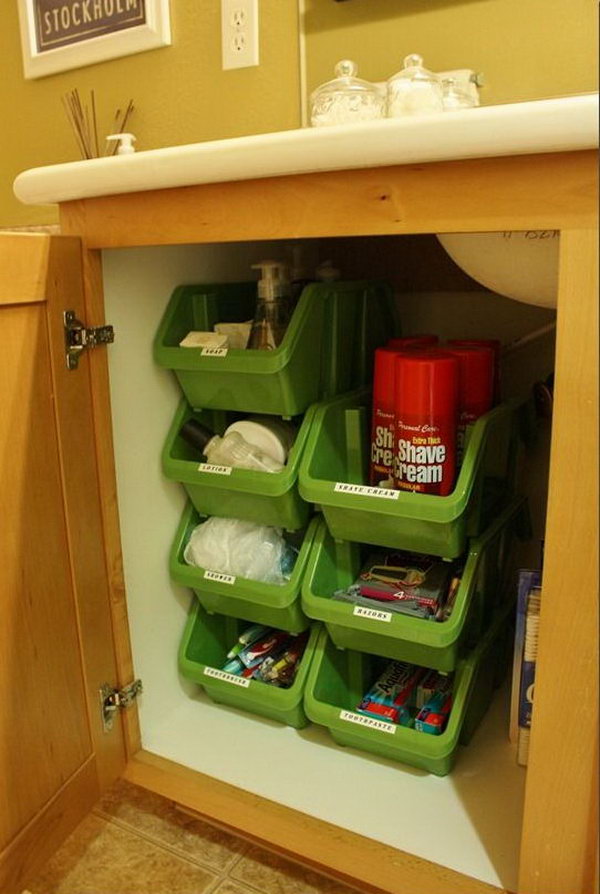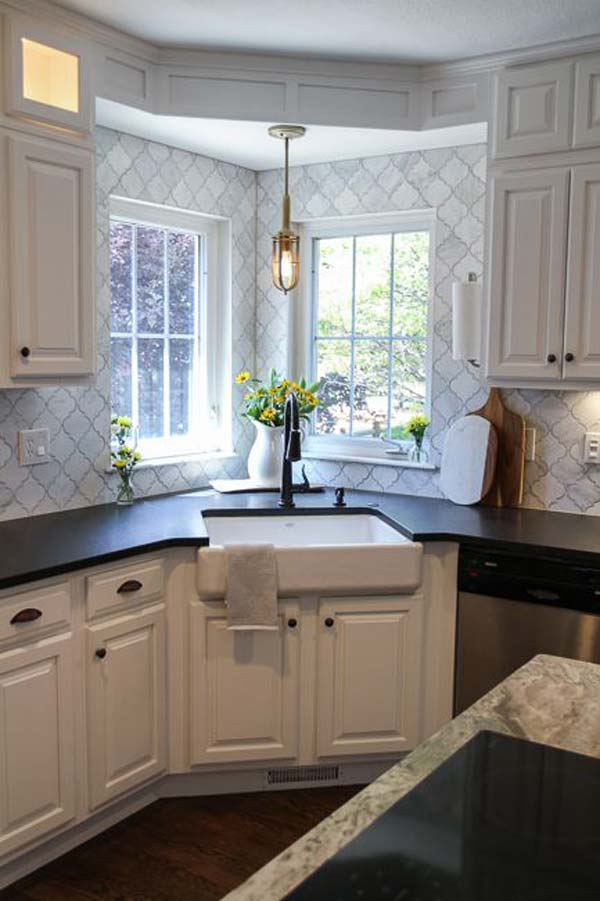Maximizing the storage potential of your kitchen sink cabinet is an often overlooked but essential aspect of kitchen organization. The space under the sink, although compact and usually irregularly shaped due to plumbing, offers prime real estate for storing essential cleaning supplies, tools, and other items. However, without a proper strategy, this space can quickly turn into a chaotic mess. With the right approach, you can transform your under-sink cabinet into an organized haven that is both functional and aesthetically pleasing. The key to successful kitchen sink cabinet storage is a combination of practical organizing tools, efficient space usage, and regular maintenance. From simple dividers to custom shelving solutions, there are countless ways to optimize this space.
One of the most effective ways to manage the space under your kitchen sink is by using stacking bins or containers. These allow you to group similar items, such as dish soap, sponges, and cleaning sprays, making them easier to access and preventing them from getting lost in the clutter. Clear, labeled bins are particularly helpful, as they allow you to see the contents without having to rummage through them. Additionally, you can easily stack these containers to make use of vertical space that might otherwise go unused.

Consider installing pull-out shelves or drawers. These are a game-changer for maximizing storage and accessibility. Instead of bending over to reach items tucked away in the back of the cabinet, pull-out shelves bring everything to the front with ease. These shelves are especially useful if you store heavy or bulky items under the sink, such as large bottles of cleaning products or small appliances. With pull-out drawers, everything remains neatly organized and within reach.
An adjustable tension rod is another innovative way to utilize space in the kitchen sink cabinet. By installing a tension rod across the width of the cabinet, you create a convenient place to hang spray bottles. This not only keeps them off the bottom of the cabinet, freeing up floor space, but it also makes them easily accessible when you need them. The rod can be adjusted based on the height of the cabinet and the size of your bottles, providing a customizable storage solution.

Utilizing door-mounted organizers can also significantly increase your storage capacity. These organizers, which come in various sizes and materials, can be attached to the inside of the cabinet doors to store items like sponges, dish soap, or even small tools. The key is to choose organizers that are slim enough so the doors can still close easily. This method is ideal for keeping frequently used items within arm’s reach, without taking up space on the cabinet’s shelves or floor.
Another smart solution is to install small hooks or clips on the walls of your cabinet. These can be used to hang cleaning brushes, gloves, or even a small towel. Hooks are inexpensive, easy to install, and can help keep items off the bottom of the cabinet where they can get wet or dirty. Clips, on the other hand, can hold dish gloves or bags of trash liners, keeping them out of the way but still accessible.

For those with deeper cabinets, a lazy Susan or rotating tray can make a big difference. These circular organizers can be placed in the corner of the cabinet, allowing you to easily rotate and access items stored at the back. It’s especially useful for organizing small bottles, jars, or boxes that might otherwise get lost in the depths of your cabinet. With a lazy Susan, you can easily spin it to bring whatever you need to the front.
It’s important to remember that while maximizing storage space is essential, safety should also be a priority. If you store hazardous materials, such as bleach or other chemicals, under your sink, consider using childproof locks on your cabinet doors, especially if you have young children. Additionally, ensure that all chemicals are stored in a way that minimizes the risk of leaks or spills. This might mean placing potentially harmful products in sealed bins or containers.
If your kitchen sink cabinet has pipes running through it, consider using adjustable shelves. These shelves can be cut or modified to fit around the pipes, allowing you to make the most of the available space. Adjustable shelves also let you customize the height to accommodate taller items like cleaning supplies, making them an excellent option for odd-shaped cabinets.

Consider using baskets with handles for easier retrieval. If your sink cabinet is particularly deep, baskets can be a lifesaver. Store items in categorized baskets and use the handles to pull them out like drawers. This prevents the need to reach awkwardly into the back of the cabinet, and the baskets can be labeled for added organization.
If you struggle with moisture or odors under your sink, place a moisture-absorbing product like silica gel or an odor-neutralizing product like baking soda in the cabinet. These can help keep the area dry and fresh, preventing mold and mildew from developing. Proper ventilation is also essential. You can install small vented cabinet panels to ensure air circulation, which helps in keeping the space clean and dry.
An often-underutilized space is the vertical area above items stored under the sink. A small wire rack or shelf riser can help you capitalize on this vertical space. You can store cleaning products underneath the riser and keep sponges, brushes, or dish towels on top. This method adds an extra layer of organization and prevents items from piling up on top of each other.
![]()
One critical consideration when organizing your sink cabinet is the type of storage products you use. Opt for products that are easy to clean and durable. Since the area under the sink can sometimes be prone to spills, it’s essential to choose storage materials that can withstand moisture and dirt. Plastic or metal organizers are generally better than wood, as they are less likely to warp or become damaged by water.
Keep a regular maintenance schedule for your sink cabinet. Once you’ve organized the space, it’s essential to maintain it by periodically cleaning and decluttering. Set a reminder every few months to check for expired cleaning products, organize any new items, and clean the cabinet itself. This will prevent it from becoming messy and disorganized again.
Last, customizing your cabinet based on your needs is key. Think about what you use most frequently and place those items in easily accessible spots. Conversely, items that you rarely use can be stored in the back or less convenient areas. Tailoring your storage solutions to your habits will make your kitchen routine smoother and more efficient.

Common Mistakes to Avoid
One of the most common mistakes people make is storing too many items under the sink without proper organization. This often leads to clutter and makes it difficult to find anything when needed. Another mistake is failing to take advantage of vertical space. People often only store items on the cabinet floor and overlook the potential for stackable storage.
Additionally, placing cleaning chemicals directly on the cabinet floor without any protective liner can cause damage due to spills or leaks. It’s also easy to forget to regularly clean and declutter the cabinet, which can result in a build-up of unnecessary items. Lastly, not customizing the storage solutions based on the shape of the cabinet or the plumbing layout can lead to wasted space.

How do I prevent my kitchen sink cabinet from becoming cluttered?
The best way to prevent clutter is by implementing a storage system that categorizes and contains items. Use bins, baskets, and drawer organizers to group similar items together, and ensure each category has a dedicated space. Regularly clean out the cabinet, removing expired or unused products. By staying on top of the organization, you’ll prevent clutter from accumulating.
What should I avoid storing under my kitchen sink?
It’s best to avoid storing any food items or materials that can be damaged by moisture under the sink. Additionally, flammable items should be kept far from any plumbing or electrical fixtures. If you have hazardous chemicals or cleaners, ensure they are properly sealed and stored to prevent leaks or spills.
How can I protect the cabinet from water damage?
Water damage can occur if there are leaks or spills under the sink. Use a waterproof liner or mat on the bottom of the cabinet to protect it. Periodically check for leaks around the pipes and ensure all stored items are in water-resistant containers. Also, avoid placing products directly on the cabinet floor if possible.

What’s the best way to store cleaning products under the sink?
Cleaning products should be stored in clear, labeled bins or baskets to prevent them from getting mixed up. Hang spray bottles on a tension rod to free up floor space, and store frequently used items in easy-to-reach areas. For added safety, ensure that harmful chemicals are stored in sealed containers and away from the reach of children or pets.
How do I organize a cabinet with plumbing pipes in the way?
Cabinets with plumbing pipes can still be organized efficiently. Consider using adjustable or custom shelves that fit around the pipes. You can also use stackable bins or baskets to make use of the vertical space while placing taller items around the pipes. Hooks and door organizers are also excellent for maximizing space in awkwardly shaped cabinets.
How often should I clean and reorganize my sink cabinet?
It’s a good idea to clean and reorganize your sink cabinet every few months. This helps prevent the build-up of clutter and allows you to check for leaks or damaged items. Regular cleaning also helps maintain the hygiene of the space, especially since the area can be prone to moisture and spills.

Under Sink Kitchen Storage Drawer

Kitchen remodel small, Diy kitchen remodel, Home decor

Related Posts:
- 3 Hole Stainless Steel Kitchen Sinks
- Kohler Langlade Undermount Kitchen Sink
- Kitchen Sink Plumbing Diagram With Garbage Disposal
- Cast Iron Double Bowl Kitchen Sink
- Elkay Celebrity Kitchen Sinks
- Leaking Shut Off Valve Under Kitchen Sink
- Kitchen Sink Productions
- Kitchen Sink Cabinet Drip Tray
- How Close Can A Socket Be To A Kitchen Sink
- Swanstone Single Bowl Kitchen Sink